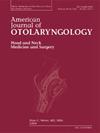低分割伽玛刀放射治疗前庭神经鞘瘤的早期结果
IF 1.7
4区 医学
Q2 OTORHINOLARYNGOLOGY
引用次数: 0
摘要
目的:立体定向放射治疗前庭神经鞘瘤(VS)以前仅包括伽玛刀(GKRS)立体定向放射手术或linac放射治疗(LBR)。低分割伽玛刀放射治疗(hfGKRS)是一种新的方案,可能比替代方案产生更小的毒性。本研究考察了连续接受hfGKRS治疗的VS患者在肿瘤控制、并发症和听力保护方面的早期结果。研究设计:对2017年至2023年在某学术中心接受原发性hfGKRS治疗的所有单侧VS患者进行回顾性研究。背景三级转诊中心干预治疗主要结果分析治疗前后影像学、笔记及听音图。将肿瘤体积制成表格。记录的听力数据包括纯音平均值(PTA)、单词识别评分(WRS)和语音接收阈值(SRT)。收集的数据包括耳鸣、失衡、House-Brackmann评分和面部痉挛。将所得结果与GKRS和LBR的文献对照进行比较。结果共检出hfGKRS病例25例。肿瘤平均体积为1.79 cm3(范围0.14 ~ 9.29cm3)。患者平均随访28个月(6-86个月)。治疗前和治疗后的听力结果分别为:PTA 62.9 dB对68.6 dB, WRS 40%对30.8%,SRT 33.1 dB对34.1 dB。在治疗前听力正常的患者中,肿瘤控制率为96%,听力保留率为80%。hfGKRS并发症包括耳鸣(12.5%)、头晕(12.5%)、面部疼痛(8%)和面部痉挛(4%)。结论hfGKRS治疗VS的短期效果与文献报道的GKRS和LBR相比,肿瘤控制率高,听力效果好,并发症发生率相当。需要进一步的随访来充分评估hfGKRS在肿瘤控制、毒性和听力结果方面的长期结果,以便将该技术与GKRS和LBR进行比较。然而,这些结果支持进一步评估hfGKRS作为一种潜在的技术来改善立体定向放射治疗VS的结果。本文章由计算机程序翻译,如有差异,请以英文原文为准。
Early results with hypofractionated gamma knife radiotherapy for treatment of vestibular schwannoma
Objective
Vestibular schwannoma (VS) management with stereotactic radiation previously only included stereotactic radiosurgery with Gamma Knife (GKRS) or LINAC-based radiotherapy (LBR). Hypofractionated Gamma Knife radiotherapy (hfGKRS) is a novel protocol potentially producing less toxicity than the alternatives. This study examines early results in tumor control, complications and hearing preservation outcomes in a consecutive series of VS patients treated with hfGKRS.
Study design
A retrospective review was conducted for all patients with unilateral VS treated with primary hfGKRS at an academic center between 2017 and 2023.
Setting
Tertiary referral center.
Interventions
Therapeutic.
Main outcome measures
Pre- and post-treatment imaging, notes and audiograms were analyzed. Tumor volumes were tabulated. Audiometric data recorded were pure-tone average (PTA), word recognition score (WRS), and speech reception threshold (SRT). Collected data included tinnitus, imbalance, House-Brackmann score, and facial spasms. Outcomes obtained were compared to literature controls of GKRS and LBR.
Results
Twenty-five hfGKRS cases were identified. Mean tumor volume was 1.79 cm3 (range 0.14–9.29cm3). Mean patient follow-up was 28 months (range 6–86 months). Pre-treatment versus post-treatment hearing results were: PTA 62.9 dB versus 68.6 dB, WRS 40 % versus 30.8 % and SRT 33.1 dB versus 34.1 dB. The tumor control was 96 % and hearing was preserved in 80 % of patients with pre-treatment serviceable hearing. hfGKRS complications included tinnitus (12.5 %), dizziness (12.5 %), facial pain (8 %), and facial spasms (4 %).
Conclusion
Short term results for VS treated with hfGKRS had high rates of tumor control, favorable hearing results and comparable complication rates to literature reports for GKRS and LBR. Further follow-up is needed to adequately evaluate long-term outcomes of hfGKRS in tumor control, toxicity and hearing results in order to compare this technique with GKRS and LBR. However, these results support further evaluation of hfGKRS as a potential technique to improve outcomes in stereotactic radiation treatment of VS.
求助全文
通过发布文献求助,成功后即可免费获取论文全文。
去求助
来源期刊

American Journal of Otolaryngology
医学-耳鼻喉科学
CiteScore
4.40
自引率
4.00%
发文量
378
审稿时长
41 days
期刊介绍:
Be fully informed about developments in otology, neurotology, audiology, rhinology, allergy, laryngology, speech science, bronchoesophagology, facial plastic surgery, and head and neck surgery. Featured sections include original contributions, grand rounds, current reviews, case reports and socioeconomics.
 求助内容:
求助内容: 应助结果提醒方式:
应助结果提醒方式:


